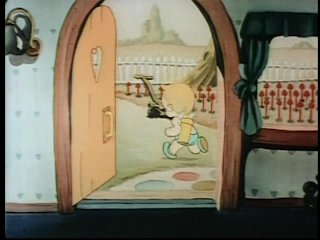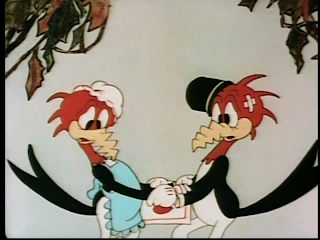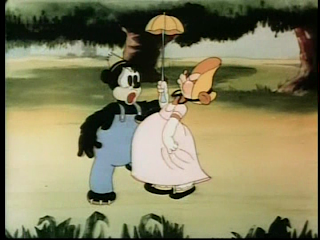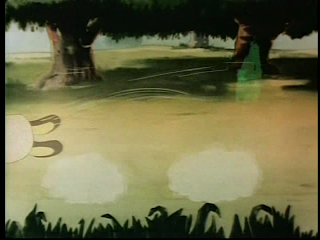the unreliable IMDb gives a release date of 12/30/1936 for this film. BCDb says 11/7/1936 is the release date. They give 4/10/1948 for its Blue Ribbon re-issue, which is the version that survives today.
DVD/BLU-RAY AVAILABILITY:
NONE AT PRESENT
You can watch a decent color print of this cartoon HERE. Thanks to Devon Baxter for his help with this. If you're not familiar with this cartoon, please watch before you read--thanks!
Like the earlier I'd Love To Take Orders From You, this film is Avery at half-strength. It's another attempt to make an appealing mass-market Technicolor cartoon. That it's done with greater humor and film-making attests to Avery's constant ambition to grow as a creator and show his colleagues and rivals what he could do.
Unlike the earlier cartoon, Don't Look Now has a more pointed, direct narrative, and takes advantage of every attempt to cram something funny into its footage. In retrospect, knowing what lays ahead for the Avery unit in their 1937 films, this cartoon seems less impressive than it ought to.
Avery's comedic sense held a high place for polar opposites. They are usually diametric in their outlook on life, intelligence, and social status. Here is a more direct good vs. evil confrontation--although Avery seldom has outright villains. His "evil" figures are often more colorful, decisive and aggressive than his passive "good guys."
To better contrast black and white, it's always best to start on the bright side. In the cartoon's first third, we view both faces of the situation. Avery enjoyed clever visual transitions, early in his career, and this one is typical of that trend:
The heart shapes, aimed toward the center of the screen, get the message across instantly: here's our protagonist, at the start of his big day...
"Well! St. Valentine's Day..."
"...my big day!"
Avery characters are often obsessive-compulsive in achieving their chosen goal, or job, and Dan Cupid is no exception. Every facet of his life involves his quest to unite lovers and let billing, cooing and eventual matrimony occur.
He grows his own arrows, which he methodically mows right into his quiver...
He uses an unplugged electric toaster as a launching device for a deck of cards.
His aim is true...
...a feat which he further proves for us via this spin on the William Tell bit.
Getting a screenshot of this next image took about 30 tries.
He gives us a high sign, similar to something James Cagney might have done in one of his breezy 1933 comedy-dramas, and (because Avery loves to show things in threes), gives us one more eyeful of his archery skillset:
Dan knocks down all ducks in his row--save for the last one, which develops consciousness and decides that it and the arrow aren't suitable company...
(SPOILER ALERT: Duck gets arrow in tookus.)
His intentions clearly stated via sign (another constant Avery device), Dan heads off to stir up some lovey-dovey action.
Okay, this is the ostensible good guy... so what's his doppelganger? Don't worry--Avery is wringing his hands at the prospect.
The nameless devil lives in a ritualistic shadow of Dan Cupid... every aspect of his home life is a dark counter to Dan's goody-goody ways.
Mesothelioma was not a concern in 1936; hence the asbestos pillow.
Character-defining visual metaphor is another essential of Avery's screen comedy. In all ways, these two opposites are predestined to be exactly who they are.
"St. Valentine's Day... my big day!"
The demon-ette addresses us directly with a rant against Cupid's value system:
"Aw, this Valentine Day gag is the bunk!"
"Love... kisses... sweehearts..."
...sissy stuff!"
Thesis stated cleanly, and with modern vernacular. This is all Avery needs to let loose. Cut to our first set of suitors...Cupid addresses us as he sings a rewrite of the Warren-Dubin title ditty, its lyrics recrafted to comment on the scene's events.
(ASIDE: as these cartoons were designed to plug the Warner Brothers song publishing catalog, it seems odd that the song lyrics were so often rewritten therein. Perhaps the studio assumed viewers would already be familiar with the songs via their appearance in live-action features...)
Tip to lovestruck turtles: the Chevalier routine always slays 'em!
Her reaction is to leap into his shell--a bold move for any 1936 cartoon character. "For two can live together [unintelligible] cheaper than one," indeed!
Everyone's happy, including proud Dan Cupid, who goes on singing...
Dan is, quite honestly, a bit hard to stomach, so it's with relief that we see another romantic union thwarted by our prehistoric Hot Stuff stand-in... after he has a go at singing rebuttal lyrics to Cupid's la-de-dah self-confidence (not seen here, because life's too short)...
"Will ya go sit on a tack, y'ol' horse face?"
Proposal ruined... exit demon, laughing.Demon confides in us. "I got somethin' here dat'll fix these love sick mugs..."
"Take a gander at this!"
Indeed, the demon imp has a one-stop shop of mayhem items, guaranteed to shatter romantic moments and cause ill will amongst cooers and billers everywhere.Example given: an ethnic woodpecker couple, who talk in catchphrases obviously derived from Bert Gordon's "Mad Russian" routines on Eddie Cantor's popular radio program.
"How do you like to be my Valentine, kiddo?"
"Do you mean it?"
"Yes, I mean it!"
"Shall I tell him?"
One long blonde hair, comin' up!
Romance on the rocks... or is it? Here comes that #@(^%@ Dan Cupid again...
Avery is still in love with unusual ways to reveal actions, and this arrow-through-the-window is a fairly clever e.g.Cupid's arrow solves the blonde hair issue--and how!
(Woodpecker warning: the billing part of billing and cooing may be hazardous to your health.)
We cut to a she-skunk, who, like the male protagonist of Avery's 1948 classic, Little 'Tinker, desires love outside of her species. Dan Cupid again intervenes. Here's what happens:
This seemingly unconnected moment will pay off late in the cartoon, so keep it in the back of your mind.
Speaking of back, we return to the emotionally conflicted bear couple...
(female bear sports the wonderful "balloon animal" drawing style of Deco-era Avery)
...who find their problem fully repaired!
Another arrow-to-the-ass is needed to help the male bear stutter out his proposal.
Marriage proposal accepted!
Wedding time... male bear calls on intended spouse. Destination: shoes and rice!
Close up of what potential wifey sees, loving detailed and worthy of a longer linger than the cartoon proper accords us.
She is not amused.
But a quick ass-arrow changes her discord to a love song.
Hubby-to-be bear gets a concentrated dose of the emotional roller-coast of married life. He seems to like it...
But we cut away to a climactic confrontation between love and hate. Hate fights dirty--and in this beautifully timed ballet of struggle, we almost feel like rooting for him!
This looks like Charles M. Jones' animation to me in this long, masterful sequence.
Cupid painfully achieves leverage...
The demon's tail makes a decent faux-arrow!
Treed, and none too pleased, he's temporarily dealt with. Smug Cupid repairs to the chapel post haste....
...while the bear pair nears the altar.
Cut to EXTERIOR: CHAPEL, where the derbied demon bribes two naive cubs to really bollix things up!
The couple stands before the preacher...
The groom is slightly nervous (repeat next two frames 100 x for best effect)...
The minister offers the traditional provision: if anyone objects to this union of holy matrimony, let him speak now, or forever hold the peace...
Reverent silence: groom bear seems both worried and relieved.
"DADDY! DADDY!"
In this cartoon's funniest moment, the groom's reputation is scandalized--before an audience that seems to find it as funny as we.Ruin! All is lost! The horrified bride flees the chapel, as Demon-boy laughs his tail off outside.
This misdeed is witnessed by Dan Cupid, who takes aim at the most obvious target in the group:
Love finds Demon-boy...
On a roll, Cupid re-re-re-re-fixes the bears' domestic dispute.
They re-enter the chapel; all seems well, and then...
What the---?
RUN FOR COVER!
Stained glass is broken as the chapel is emptied...
Remember the incidental skunk character? Yep, that's all, folks!
Good-natured but undeniably weak, Don't Look Now is a minor slice of the Avery pie at Warner Brothers. The topic and subject matter, to be frank, is beneath Avery. His determination to do a good job, despite the odds, saves the cartoon from oblivion.
Funnier than it has a right to be, Don't Look Now fails to engage Avery the comedian sufficiently. The greatest stride made here, by Avery, is his increased casual approach to character-to-audience communication. With each successive cartoon, this interaction of screen and moviegoer becomes more off-handed, and more integral to the overall effect.
The less of a big deal made about this breach, the better. This approach will soon influence both animation and live action. Matter-of-fact asides to the passive viewer, who has no way to change the course of projected on-screen events, was one of the liveliest tools that came to motion pictures in the 1930s.
Avery deserves a great deal of credit for making audiences comfortable with this concept. What might be a jarring detachment from the audience's tacit suspension of disbelief contract with the silver screen becomes a means to bring pre-made entertainment and live audience closer. These cartoons still achieve a rapport with the viewer that is easily gauged in the rare event that they're screened to a live audience.
This off-the-cuff approach to bridging past, present and future continues to be a staple of TV and movie technique. Certainly, if Avery hadn't been so hooked on it, someone else would have done so. Many films before Avery's attempt this casual dialogue with their viewers.
1937 will be the year Avery makes great strides to bring fiction and real life closer together, through this technique. We will begin our survey of this fateful year with our next installment, which I hope shall come sooner than the lapse between the last posting and this one!
UP NEXT: Porky the Wrestler (1937).






















































































































































































As you note, this is in the same vein as "I'd Love to Take Orders from You", which in turn feels like a Freleng/Harman-Ising Merrie Melodie of the 1931-36 period, in that we're being asked in some way to take the conflict between Dan Cupid and proto-Hot Stuff seriously. Avery puts a little more bite into this one than into the earlier effort, but it still seems out of place, as far as the direction Tex was headed (though not as out of place as 1938's "The Mice Will Play", since here we're at least still in the period where Warners was unsure how far they could stay from the Disney story model and get away with it).
ReplyDeleteI guess cries of "Mommy! Mommy! Mommy!" from the cubs might have been too scandalous for a 1936 audience. A "virginal" bride with two kids? Heaven forfend! Five-fend even!
ReplyDeleteHello from Belgium,
ReplyDeletelink is dead, I found these one :
https://www.dailymotion.com/video/x3j48n9